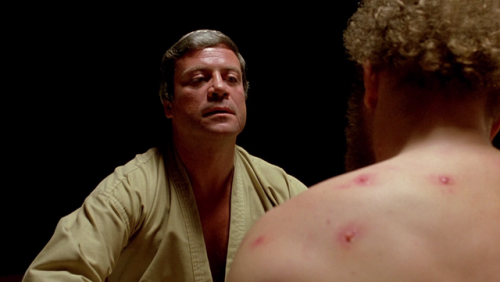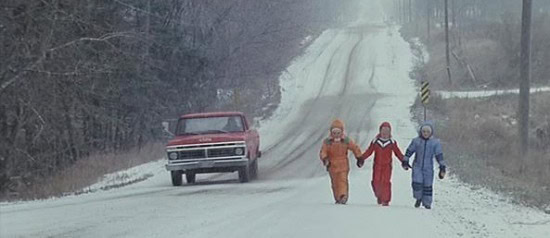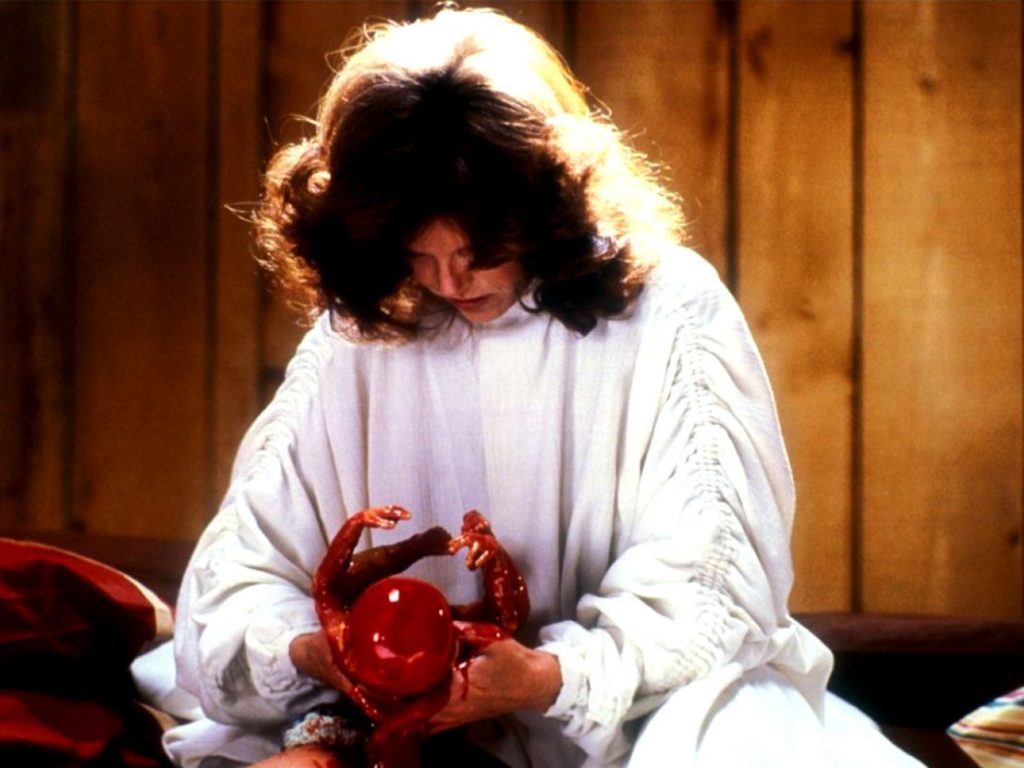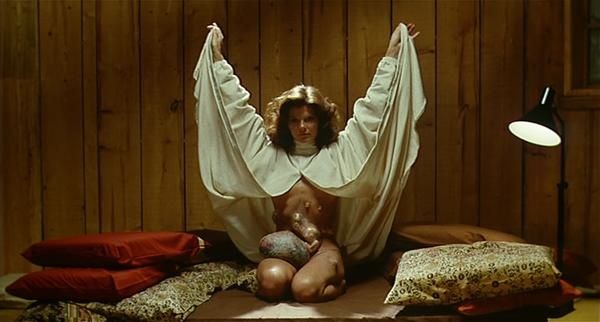Shivers (1976) and Rabid (1977) established Canadian director David Cronenberg at the forefront of psychosexual body horror and The Brood (1979) caps off his 1970s work with a flourish. Within Cronenberg’s unique vision, human flesh is itself monstrous, capable of mutating, detaching, slithering, and destroying its progenitor. His movies of this decade burrow deep inside the human reproductive system and the urges that drive it, emerging drenched in blood and quite, quite demented. They refract male envy of pregnancy and childbirth by presenting alternative, non-sexual methods of reproduction. These narratives straddle the border between science fiction and horror, often including a cool, dispassionate doctor who, when consulted, regards the abominations of nature on display with only mild curiosity, as if they are the predictable consequences of human evolution: This is who we really are, this is what has always bubbled beneath our skin. Step across the threshold and embrace it.
The Brood builds on the visceral dimensions of Cronenberg’s earlier films by adding a new, and brutal, emotional layer. The title is both noun and verb: a woman broods over wrongs done to her in the past, her resultant anger takes on physical form as a brood of monstrous children. In writing the script he drew on his personal experience with a divorce and custody battle and famously referred to it as “my version of Kramer vs. Kramer” – if Kramer vs. Kramer were about the very special hatred that exists only between a husband and wife manifesting in the form of killer child-monsters. The horror is mixed with family melodrama, as the disintegration of the relationship between Nola and Frank drives the first two acts. The monsters in The Brood don’t come from outer space, or from a laboratory (although it takes a scientist to free them). They originate in the power of human emotion, birthed by a woman’s rage.
The Brood is also satirical, taking aim at some of the excesses of the Me Decade during which the pursuit of happiness usually involved the quest for a good shrink – or the right pill to pop. The simplest approach was to find a primary care doctor willing to prescribe copious quantities of your preferred medication. Psychotherapeutic drug use exploded across the USA early in the 1970s – the Journal of the American Medical Association reported that by 1972 “13% of the men and 29% of the women had used such prescription drugs–in particular minor tranquilizers and daytime sedatives.” Clinical psychologists, unable to prescribe drugs, emphasized their role as “caring professionals” and extolled the benefits of various types of talking therapy. Despite the growing national obsession with fixing broken minds, there was no overall increase in mental well-being – in fact, by 1979, psychiatrist Leslie Farber, writing in Psychology Today, declared “sometime in the present decade, the Age of Anxiety became the Age of Depression.”1
It’s not surprising, then, that Cronenberg selects misguided psychotherapy as one of the main targets of his satire, via the buzzword-y “psychoplasmics” system that triggers the unfortunate events of the plot. It’s never fully explained how Dr. Raglan’s unconventional methods are meant to cure his patients of their mental illnesses or relieve their trauma, but nonetheless people are in awe of his process, which eschews drugs in favor of an extreme and immersive form of talk therapy. Like a cult leader, he chips away at his patients’ psychic defenses until they accept his way is the only way towards recovery, and jostle one another for the privilege of participating in one of his painful and debilitating therapy sessions. He seems to make a lot of money (enough to run a state of the art residential clinic, the snarkily named ‘Somafree Institute’) from subjecting his patients to his endless roleplay games despite the fact that one of the side effects of his treatment appears to be cancer. Eventually Raglan faces up to the fact that his techniques cause more harm than good, but his attempts to mitigate the damage are too little, too late.
Divorce also loomed large within the zeitgeist, and was a more immediately personal issue for Cronenberg. The rising divorce rates of the 1970s-80s were the result of more permissive laws regarding marriage dissolution coupled with the gains made by second-wave feminism. Women were increasingly able to earn their own living and no longer had to remain financially dependent on their husbands. The changing legal framework meant it was easier than ever before to petition for a divorce, although custody of any children was usually given to the mother. Despite the increasing ease of the process, Splitsville still led to heartache for everyone concerned.
Within The Brood, Cronenberg lays bare the failure of two marriages and explores the emotional fractures caused by 1970s-vintage divorce. In the past, Nola’s parents, Barton and Juliana attempted to anaesthetize their misery with alcohol, but ended up abusing their child. Their behavior means the fragile Nola never really stands a chance with Frank, the drab-hued man she marries. Frank seems unwilling to meet his wife’s complex emotional needs even halfway. He tells himself “You got involved with a woman who fell in love with you for your sanity and hoped it would rub off” – in his mind, the messy divorce is Nola’s fault for failing to evolve. With clashing parents AND grandparents like these poor Candy, like so many other children of the 1970s and 1980s, doesn’t have a hope in hell of being normal or well-adjusted. Monsters beget monsters. And so the cycle continues…
The Movie
The Brood opens with a doctor-patient session presented as a lecture. Maverick psychologist Dr. Hal Raglan (Oliver Reed), creator of “psychoplasmics”, an intense form of talk therapy, demonstrates his technique to an audience. Within a roleplay exercise, he takes his patient Michael (Gary McKeehan) deep into past trauma (some serious daddy issues). Their session is so intense raw welts appear on Michael’s body – a phenomenon which elicits reverential applause (rather than alarm) from the spectators.


A latecomer, Frank Carveth (Art Hindle) is the only person looking doubtful. He already has concerns about Raglan’s technique: his soon-to-be-ex wife, Nola (Samantha Eggar) has been sequestered at the clinic for several weeks, forbidden any visitors except their five year-old daughter, Candy (Cindy Hinds). Frank has come to the Somafree Institute after seeing scratches and bruises on Candy’s back after one of her visits – he wants to know what’s going on. Raglan blocks Frank from seeing Nola and – aware that things might be about to get awkward with CPS for his patient – decides to increase the intensity of her therapy in order to hasten her cure.
Unsatisfied with Raglan’s excuses, Frank starts digging for information about Raglan and his clinic. Frank’s sure he’s not the only one with questions about the doctor’s unorthodox techniques. He leaves Cindy with her maternal grandmother, Juliana (Nuala Fitzgerald) while he goes to meet with one of Raglan’s former patients who’s now dying of cancer.
Juliana can’t babysit without an adult beverage in hand, the first clue that she may not have been the greatest mother to Nola. In fact, at the very same time as Juliana is pouring herself another refill, Nola is deep in a session with Raglan, discussing how her mother’s alcoholism used to hurt her. Raglan encourages Nola to unzip her anger, “Go all the way through it till the end.” Neither Raglan nor Nola are aware that this process will generate a child-sized homunculus, the walking, slashing physical manifestation of her matricidal thoughts. The creature, dressed in a red ski suit (evoking Don’t Look Now and Alice, Sweet Alice), lurches out of one of Juliana’s kitchen cabinets and batters her to death. If she didn’t already have enough trauma to deal with, Candy discovers her grandmother’s bloody corpse.
Nola’s long absent father, Barton (Henry Beckman) shows up for the funeral – just in time to be dispatched by the monstrous child. Frank discovers the body and is also attacked, but the creature suffers sudden heart failure and drops dead before it can do him any real harm. An autopsy reveals that the creature is humanoid, but lacks genitals, teeth, and a navel (and was therefore not born in the normal human manner). It feeds on the contents of a fleshy sac between its shoulder blades. Once that energy source is expended, it dies.
The coroner seems curiously disinterested in the provenance of the creature, but the police inspector in charge of the now-double homicide investigation has another theory, reminiscent of It’s Alive: “My guess is some crazy woman didn’t want anyone to know she had a deformed child. She’s had this kid locked up in an attic for years, and never told anybody. Wouldn’t be the first time!”
Unnerved by the simultaneous timing of his sessions with Nola and the brutal murders of her parents, Raglan closes his clinic, asking everyone but Nola to leave. With her parents out of the picture, Nola’s rage now focuses on Candy’s kindergarten teacher, Ruth Mayer (Susan Hogan), who she thinks is getting a little too cozy with Frank. Two monster children slip into the school, kill Ruth, and kidnap Candy, taking her back to Somafree, where Nola’s angry brood all bunk together in an attic.


By this time, Raglan and Frank have figured out what’s going on: psychoplasmics has caused Nola to spawn the diminutive monsters from an external womb she’s developed. She’s unaware of their existence, but they carry out her unconscious bidding – which means they track down and kill those she blames for her current unhappiness. Raglan attempts to put his genie back in the bottle by volunteering to rescue Candy from the brood attic, but is killed by the monsters he helped create. The only way to save Candy is for Frank to strangle Nola – once she’s dead, breaking her telepathic connection to her brood, they all die too.
Shaken to his core, Frank drives Candy away from the carnage in silence, unaware that his daughter is at that very moment beginning to manifest her own physical version of her mother’s rage: lesions have appeared on the girl’s arms.
Reception
At the time of its release, (mostly male) critics did not respond favorably to The Brood, perhaps because they objected to the concept of the monstrous feminine underpinning the narrative. The few seconds showing Nola licking her newborns as an animal would were cut by various censors, who left the murders intact. Rarely has motherhood been depicted as such an ugly, self-serving process and there was some uncertainty as to how the audience should handle that. Roger Ebert deemed it “an el sleazo exploitation film… disgusting in ways that are not entertaining.”2


Over the years, however, Cronenberg’s grotesque, transgressive, and impassioned rendition of the pain of divorce has received the critical acclaim it deserves, especially as psychoanalytical deconstruction of movies – especially horror –has become more culturally respectable. The final scenes of The Brood, in which Frank confronts the transformed Nola and discovers the monstrous exo-womb lurking beneath her white nightgown, ready to pop out another creature, have come under particular academic scrutiny.
In The Monstrous Feminine, Barbara Creed uses Julia Kristeva’s theory of the abject in horror 3 as a tool for understanding Nola. Kristeva suggests that the Abject (things that were once part of ourselves, but have been rejected) elicit a specific sort of horror, more visceral and disturbing than the horror caused by the Other (things which we consider opposite to, and outside of, our selves). The complex relationship between mother and child is one of abjection – we must reject our mothers in order to claim our own identities, and may be repulsed by our continuing resemblance to that parent. The prospect of turning into your mother is horrifying – but as we get older we all tend to do it.
Nola, however, transcends. She turns into a different kind of mother, one who embraces the Abject. In her final encounter with her once-husband, she pleads for reassurance that he still loves her and everything about her. When he gives his word she sweeps her arms upwards, to reveal her altered self. She has violated all the natural rules of motherhood. The movie up until this point has presented the brood as the threat, but now it’s clear Nola is the real monster. She’s done what women have always been forbidden to do: she has indulged her anger, taken it as far as she can. As well as reproducing parthenogenetically, her womb now dangles outside her body, pulsing with a new life that she will never allow to exist independently. Her children will never experience any kind of separation from her, they’re mindless, genderless, subject to her emotions rather than their own. Her pose is triumphant, look at me, revere what I have become. It’s so deeply aberrant and disturbing that it’s hardly a shock that Frank kills her. But her death is only a temporary solution. The contagion has been passed from mother to daughter. With Candy, it begins again.


Further Reading
Cronenberg, David and Rodley, Chris (editor) Cronenberg on Cronenberg (Faber & Faber 1992)
Creed, Barbara The Monstrous Feminine: Film, Feminism, Psychoanalysis Chapter 4: Woman as Monstrous Womb (Routledge, 1993)